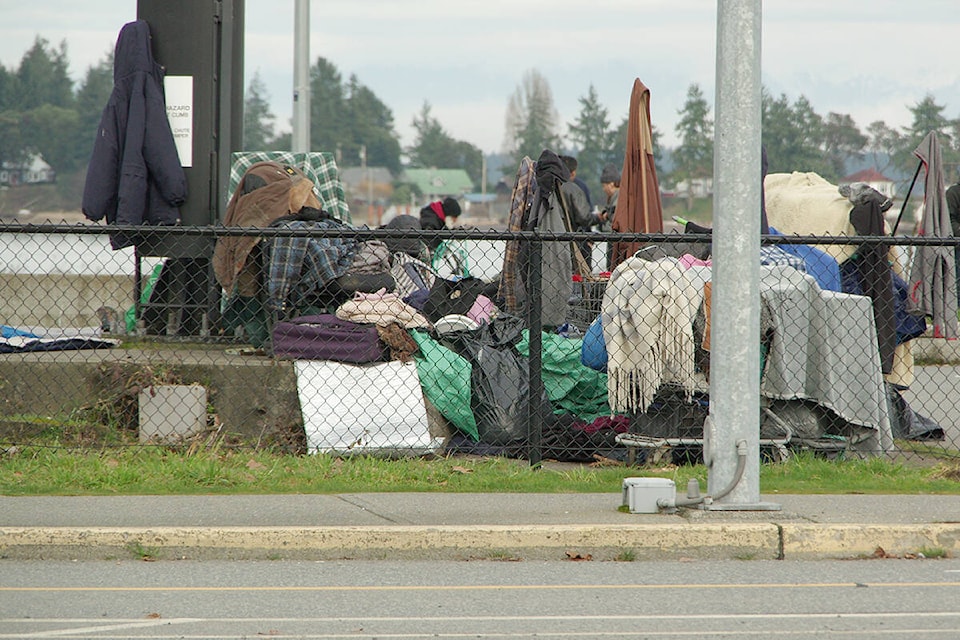The most recent Nanaimo homelessness count has tallied nearly a 20 per cent increase from the previous count, with a majority of those people having no access to any kind of shelter.
Nanaimo’s 2023 point-in-time count, presented to city council on Monday, April 8, reported 515 individuals experiencing homelessness, an 18.9-per cent increase from 2020.
The federally funded count was led by United Way B.C. and the Canadian Mental Health Association’s mid Island chapter and was held last April.
The report noted that 78.4 per cent of the people enumerated were unsheltered: sleeping rough in tents, makeshift shelters, public spaces, vehicles, or other places not fit for human habitation.
“This figure is significant as it is far higher [than] almost any other designated community that conducts [point-in-time] counts in Canada,” the report noted, adding that as a comparison, 14.5 per cent of the people experiencing homelessness in Victoria were sleeping rough.
The count found that 82.5 per cent of the respondents in Nanaimo had lived in the city for more than a year, and not a single one was a recent immigrant to Canada.
“In short, people experiencing homelessness in Nanaimo are ‘from Nanaimo,’” the report stated.
Approximately one-third of those surveyed were Indigenous, about the same as the 2020 count and an over-representation considering Indigenous people make up about six per cent of the city’s population.
As far as reasons for homelessness, more than one-third of respondents said their most recent housing loss came from eviction.
“Reasons for eviction vary quite widely, but obviously there needs to be more focus on mitigation and/or prevention given that the proportion reported is so high,” the report stated.
Andrew Thornton, research and knowledge mobilization lead with the Nanaimo Systems Planning Organization, stressed that the 515 count is an estimate and an undercount, and suggested there are closer to 800-1,000 people experiencing homelessness in Nanaimo.
“The actual number that we get is about 60 per cent of what other estimates like front-line [community safety officers], RCMP, outreach staff say,” he said.
Thornton spoke to council about the difference between sheltered and unsheltered people experiencing homelessness, comparing societal impacts, individual health impacts, and prospects for re-housing.
“This is one of the things that drives the public perception of homelessness in Nanaimo, is the fact that there are so many people regularly on the streets and they are so visible because we don’t have enough or even near enough shelter spaces…” he said. “People who are in the most crisis and need the most support are the most visible and that is not all of homelessness.”
The report concluded that the number of people experiencing homelessness in Nanaimo has been steadily increasing and has almost tripled since 2016. A major concern is the high percentage of people who are chronically homeless, and the report states that “the profound lack of access to affordable housing and adequate supports is keeping more and more people on the streets for longer periods of time.”
Thornton’s presentation noted that next steps will be to inform the community, work to reduce stigma, try to generate goodwill and innovative solutions, support service providers with funding applications, and try to make the most of any investments into shelter and other housing types.
City councillors asked a handful of questions, wondering about the uncounted people experiencing homelessness and ways to improve data collection when the next count happens as soon as this fall.
“I’m not worried about having the most accurate numbers in the world. I’d rather have them give us resources until we say stop…” said Thornton. “We do need good data, but the good data is not going to bring the solutions. The solutions are political solutions. The data helps, but we need action.”
READ ALSO: City of Nanaimo’s new homelessness-focused agency about to begin its work
READ ALSO: 2020 count in Nanaimo indicates 25 per cent increase in homelessness
